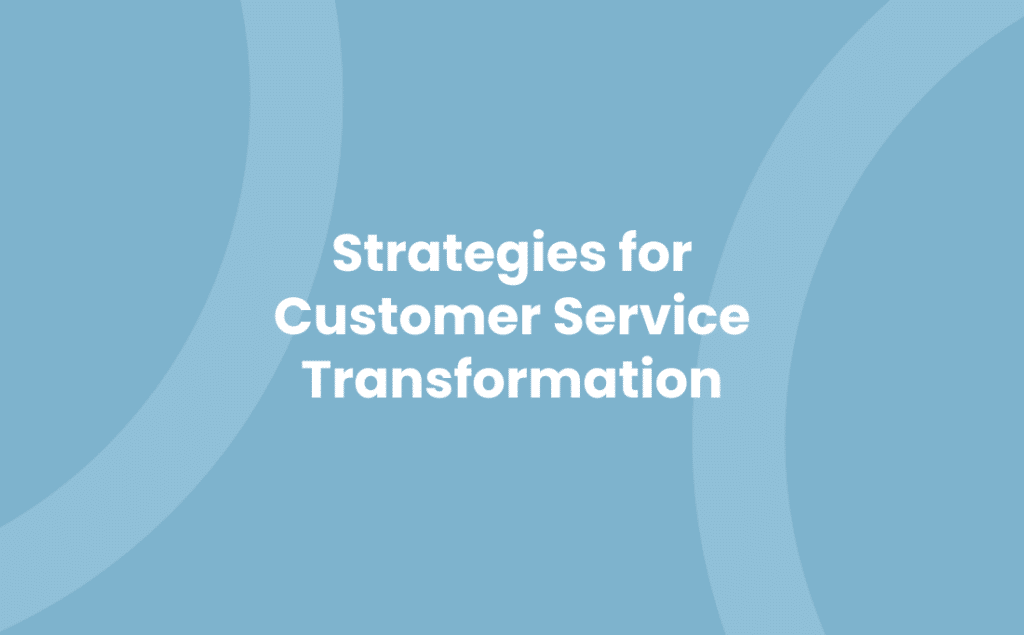In the digital age, customer service strategies have taken a revolutionary turn. It’s no longer about just answering calls and replying to emails. Today, it’s all about digital transformation. But what does that really mean for your business?
Digital transformation in customer service isn’t just a buzzword. It’s a strategic shift that can redefine your customer relationships and propel your business to new heights. In this article, we’ll delve into the heart of digital transformation and explore how it’s reshaping customer service strategies across the globe. Stay tuned for an enlightening journey into the future of customer service.
Understanding Digital Transformation in Customer Service
Imagine the day in a life of your customer service team. The phones are ringing off their hooks, emails pop in faster than they’re resolved, and a queue of customers extends as far as the leg can see. But in a twist that feels like magic, technology steps in. Now, not only do your service agents have additional tools, but your customers experience service interactions that seem straight out of a sci-fi movie.
Digital transformation customer service, you may ask? Yes, indeed. It encompasses the integration of digital technology into all business areas, causing fundamental changes in how businesses operate and how they deliver value to customers. Gone are the days of solely relying on traditional customer service methods; we’re living in an era where digital service strategies can significantly boost your business.
To comprehend how digital transformation affects customer service, consider chatbots. These little digital helpers take care of basic queries, freeing up your human agents to tackle more complex issues. They also offer rapid responses at any hour, satisfying the modern customer’s immediate gratification instinct. This instance is a clear demonstration – digital transformation revolutionises customer service delivery, leading to increased customer satisfaction and loyalty, and as a result, higher business returns.
Customer service has advanced from mere response to anticipation, fuelled by data analysis. Predictive analytics lets your business read customer behavior signs and solve potential issues even before they arise. This anticipatory service is a direct result of a comprehensive digital transformation strategy, rendering traditional reactive customer service outdated.
Then there’s social media – platforms where customers don’t hesitate to voice their concerns or ask questions. Digital transformation here translates into robust and responsive customer service on these platforms. A speedy response time spells high customer satisfaction, another tick in the digital transformation box.
In today’s digital age, any delay can lead to disgruntled customers, causing reputations to take a hard hit. As a business owner, engaging in digital transformation is no longer a matter of choice‚ it’s a matter of survival. Transforming your customer service digitally means delivering superior customer experience, driving customer loyalty, enhancing your reputation, and most importantly, keeping your business afloat in the cut-throat world of commerce. With all these advantages lined up, you’d be remiss not to consider a thorough digital overhaul in the area of customer service.
Strategies for Effective Digital Transformation in Customer Service
Harnessing digital transformation in your customer service operations isn’t easy, but it’s paramount for businesses wanting to stand out in a digitised world. Here, we offer four key strategies for effective digital transformation in customer service.
Integrate Omni-Channel Communication
Aim to integrate omni-channel communication. Taking your business online means being present everywhere—your customer-experience operations must span across multiple platforms. For example, ensure responses on social media platforms, provide assistance via chatbots, and answer questions through email and virtual help desks.
Utilise Advanced Analytical Tools
Next, you’d gain by utilising advanced analytical tools. These provide insights into your customers’ habits, concerns, and satisfaction levels. For example, predictive analytics can forecast trends, helping you adapt your services as per customer expectations.
Adopt Automation
Your third strategy: adopt automation. This frees your staff from repetitive tasks, allowing them to focus on providing personalised, thoughtful customer interactions. Take the case of automated email responses, these can significantly increase response times and customer satisfaction.
Prioritise Data Security
Lastly, give priority to data security. Protecting customer data in the digital landscape is an absolute must. Implement strict security protocols and regularly update your systems to guard against potential breaches.
Remember, the crux of digital transformation in customer service lies in enhancing customer experiences, elevating your services, and evolving with the pace of technology. By incorporating these strategies, you’re not just modernising your customer service‚Äîyou’re ensuring it’s shaped to thrive in a digitised world.
Case Studies: Successful Digital Transformation Customer Service Strategies
Delving into commendable approaches, discover how businesses enhance their customer interactions by embracing digital transformation.
- Revamp of Domino’s Pizza – Harnessing digital technologies was a game-changer for Domino’s. By ramping up online ordering systems and introducing innovative features like “Domino’s AnyWare” – allowing orders via social media, smart devices, and even through gaming consoles, Domino’s saw a massive surge in revenues. Their focus on digital customer service not only streamlined the order process but amplified customer engagement too.
- Tesla’s Strategic Approach – Tesla extends a unique digital customer experience. User analytics play a critical role in their strategy. Tesla’s cars, loaded with sensors, collect data which, when analysed, helps Tesla predict customer needs, enhance product features and proactively address issues. This strategic use of data and predictive analytics redefines the driving experience, putting Tesla a step ahead in customer satisfaction.
- Starbucks and Tailored Experiences – Starbucks excels at crafting personalised experiences with their mobile app. With features like order customisation, order-ahead, and digital payment options, speed and convenience are redefined. Moreover, they collect data to understand customer preferences and personalise offers. Such a digital transformation strategy pivoted Starbucks towards being customer-centric.
- American Express (Amex) Using Predictive Analytics – Amex utilises big data and advanced analytics to anticipate customer needs. They use spending patterns to foresee client behaviour and preferences, helping them tailor services and offer real-time support. Their digital strategies focus on customer retention and improved service delivery.
These illustrious examples aptly demonstrate the power of digital transformation in customer service. Be it enhanced online platforms, advanced analytics, extensive use of data, or the creation of seamless experiences, businesses strive to transform not just their services but the very manner in which they interact with customers. Such strategic shifts gear businesses to keep pace with customers’ evolving expectations in this digitised era. Remember, digital transformation doesn’t bring about isolated changes, it fundamentally alters your approach to customer service. Set against this backdrop, businesses that adapt and redefine their customer service strategies stand to gain hugely in the long run.
Challenges to Digital Transformation in Customer Service
Even with digital transformation customer service strategies revolutionising traditional customer relations, certain hurdles persist. As a business owner, you’re probably already familiar with some of them.
- Cybersecurity Concerns: Implementing digital strategies introduces new susceptible points for hackers and malware, provoking a solidified emphasis on cybersecurity. Businesses often grapple with securing customer data while ensuring seamless digital experiences.
- Cost Implications: Digital equipment and systems can represent a hefty investment. Smaller businesses, particularly, might struggle to allocate sufficient funds towards high-end digital service strategies, even when the return on investment promises increased efficiency.
- User Adoption and Training: While your team might be quick to assimilate novel digital tool functions, remember that your customers also require a gentle transition. The need for user-friendly interfaces, interactive tutorials and robust customer support systems ascend.
- Technological Innovation Pace: In an age of ever-evolving technological advancements, keeping up can be daunting. Implementing one system only to find out a newer, more efficient version is available can set businesses back both time and money.
- Multi-channel Coordination: Customers seek seamless transition between communication channels. The challenge lies in integrating and synchronising multiple channels such as websites, social media, phone, and email to provide a cohesive service experience.
Navigating these challenges calls for a comprehensive understanding of your unique business requirements coupled with the proper application of digital service strategies. Stay resilient; it’s about reckoning the bottlenecks one by one and turning them into opportunities for growth.
Role of AI in Digital Transformation Customer Service Strategies
Delving deeper into digital transformation customer service, artificial intelligence (AI) becomes a crucial player. AI contributes significantly to refining digital service strategies and driving customer satisfaction to towering heights.
Artificial Intelligence optimises customer interactions in a digital landscape, playing a critical role through its versatile applications. Response automation ranks as a prime AI use, with chatbots responding to customer queries instantly, thereby reducing wait times. For instance, banking services often employ AI chatbots to promptly address customer queries, without any tedious delays.
AI also aids in predictive intelligence, forecasting customer requirements before they express them. It analyses customer interaction patterns and purchases to anticipate their needs. This pre-emptive approach leads to personalised offerings, fostering robust customer relationships.
The usage of AI isn’t all sunshine and rainbows, as cybersecurity remains a substantial concern. AI data must remain secure to maintain customer trust. Striking a balance between AI application and security proves pivotal when refining your digital transformation customer service.
Cost is another factor affecting AI applications in customer service strategies. Despite initial investments seeming daunting, the returns yield value in enhanced customer experience and increased loyalty rates.
Lastly, AI fuels multi-channel coordination. Customers today interact with businesses through various digital avenues. AI collates customer data from all these points, ensuring a cohesive and personalised customer experience across multiple platforms.
Thus, AI marks a significant role in your digital service strategies. Offering an amalgamation of prompt response, predictive intelligence, and multi-channel coordination, it guarantees a seamless digital transformation in customer service strategies.
Reference your business requirements, analyse the pros and cons, and understand how AI fits into your transformation journey. It’s not only about embracing technology, but also employing it efficiently to turn challenges into growth opportunities. You’re navigating the complexities of the digital realm, and AI is certainly your trusted co-captain on this voyage.
Remember, AI is not merely a technology to adopt; it’s a strategic tool designed to enhance customer satisfaction and catapult your business into the future. In the ever-evolving world of digital transformation, it pays to be one step ahead. Consider AI your means of unlocking the secrets to unprecedented customer service success.
The Future of Customer Service: A Digital Transformation Perspective
Predictive analytics and AI play a fundamental role in the progression of digital transformation in customer service operations, portraying the landscape’s future. This stage of metamorphosis anticipates a fusion of existing AI with advancements such as blockchain technology and Internet of Things (IoT) devices to further consolidate digital service strategies.
One prominent shift lies in the incorporation of IoT mechanisms into customer service systems. As interconnected devices collect customer data, it extracts valuable insights revealing customer behaviour patterns. This functionality transforms traditional reactive customer service to proactive, forecasting potential issues and formulating solutions before they develop.
Embracing blockchain technology into your digital service strategy strengthens security protocols. Given blockchain’s transparency and immutability, transactions maintain authenticity and refute potential fraudulence, which is crucial amid concerns about cybersecurity. Customer trust in your service strengthens as you fortify your system’s integrity.
Artificial intelligence’s role as the anchor of digital transformation in customer service continues to expand. Future trends suggest the rise of AI-enabled video chatbots, capable of facial expressions and emotional recognition. Recognising customers comportment, chatbots incite personalised and empathetic solutions, demonstrating a naturally human-like interaction that harnesses customer rapport.
As we embrace a digitally transformed future, remember that implementing these technologies calls for an organisational mindset prepared for digital adaptability. The dynamics of the digital landscape, though challenging, urge firms to constantly learn, unlearn, and relearn digital service strategies. The sustainability of your digital transformation journey depends on the capacity to accept change, adapt, and innovate.
Embrace these advancements, and your grasp on the pinnacle of customer service excellence in the digital age is tighter than ever.
Conclusion
So, you’ve seen how digital transformation is reshaping customer service strategies. Embracing the likes of chatbots, predictive analytics, and AI can truly revolutionise your customer interactions. Yet, it’s not without challenges. Cybersecurity, costs, and user adoption are hurdles you’ll need to overcome. But with a clear understanding of your business requirements, these can be navigated successfully. Looking forward, integrating AI with IoT and blockchain technology will be key. Not only will this enhance your security protocols and build trust, but it will also enable proactive service through behaviour pattern analysis. AI will play an ever-expanding role, with video chatbots personalising interactions further. So, it’s time to adopt a digital mindset, navigate the challenges, and strive for customer service excellence in this digital age. Your customers demand it and your business will thrive because of it.


